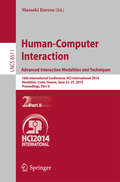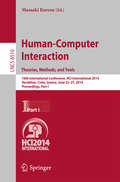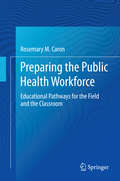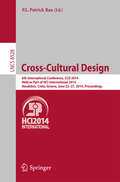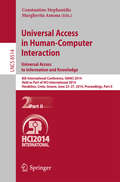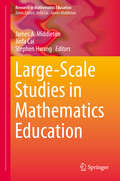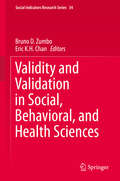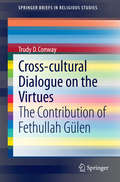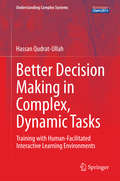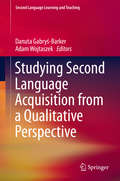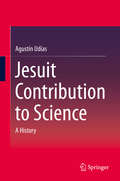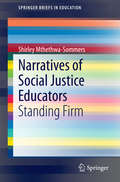- Table View
- List View
Human-Computer Interaction. Advanced Interaction, Modalities, and Techniques: 16th International Conference, HCI International 2014, Heraklion, Crete, Greece, June 22-27, 2014, Proceedings, Part II (Lecture Notes in Computer Science #8511)
by Masaaki KurosuThe 3-volume set LNCS 8510, 8511 and 8512 constitutes the refereed proceedings of the 16th International Conference on Human-Computer Interaction, HCII 2014, held in Heraklion, Crete, Greece in June 2014. The total of 1476 papers and 220 posters presented at the HCII 2014 conferences was carefully reviewed and selected from 4766 submissions. These papers address the latest research and development efforts and highlight the human aspects of design and use of computing systems. The papers thoroughly cover the entire field of human-computer interaction, addressing major advances in knowledge and effective use of computers in a variety of application areas.
Human-Computer Interaction. Theories, Methods, and Tools: 16th International Conference, HCI International 2014, Heraklion, Crete, Greece, June 22-27, 2014, Proceedings, Part I (Lecture Notes in Computer Science #8510)
by Masaaki KurosuThe 3-volume set LNCS 8510, 8511 and 8512 constitutes the refereed proceedings of the 16th International Conference on Human-Computer Interaction, HCII 2014, held in Heraklion, Crete, Greece in June 2014. The total of 1476 papers and 220 posters presented at the HCII 2014 conferences was carefully reviewed and selected from 4766 submissions. These papers address the latest research and development efforts and highlight the human aspects of design and use of computing systems. The papers thoroughly cover the entire field of human-computer interaction, addressing major advances in knowledge and effective use of computers in a variety of application areas.
Preparing the Public Health Workforce: Educational Pathways for the Field and the Classroom
by Rosemary M. CaronIn concept and practice, public health casts a wide net, spanning assessment, intervention, and policy; education, prevention, and protection; public, private, and government entities. But key elements are often missing from the picture, including a clear understanding of public health and its goals by the general public, and specific public health education throughout the workforce. Preparing the Public Health Workforce responds to these and related challenges by elegantly summarizing the state of the field in an era of dwindling budgets, competing and overlapping services, and a shaky professional infrastructure. In keeping with public health goals set out by the CDC and other leading agencies, the author makes a real-world case for standardizing training, establishing best practices in the field, and coordinating public health systems with their healthcare counterparts. Theory, case examples, tools, and callout boxes highlight knowledge, preparation, and skills professionals need in addressing chronic issues and complex emergencies. Throughout, the emphasis is on greater competency and visibility for the profession, resulting in a more informed, healthier public. Featured in the coverage: Issues in defining the public health workforce.The state of public health education.Practicing and teaching public health: local, national, and international cases.Standardizing public health practice: benefits and challenges.Integrating public health and healthcare.The future of public health as seen from academia and the frontlines. Identifying urgent issues and providing cogent answers, Preparing the Public Health Workforce is a call to action for those involved in creating the next level of public health, including professors, practitioners, students, and administrators.
Cross-Cultural Design: 6th International Conference, CCD 2014, Held as Part of HCI International 2014, Heraklion, Crete, Greece, June 22-27, 2014, Proceedings (Lecture Notes in Computer Science #8528)
by P. L. Patrick RauThis volume constitutes the refereed proceedings of the 6th International Conference on Cross-Cultural Design, CCD 2014, held as part of the 16th International Conference on Human-Computer Interaction, HCI International 2014, held in Heraklion, Crete, Greece, jointly with 13 other thematically similar conferences. The total of 1476 papers and 220 posters presented at the HCII 2014 conferences was carefully reviewed and selected from numerous submissions. The papers address the latest research and development efforts and highlight the human aspects of design and use of computing systems. They thoroughly cover the entire field of human-computer interaction, addressing major advances in knowledge and effective use of computers in a variety of application areas. The 76 papers included in this volume deal with the following topics: cross-cultural product and service design; cross-cultural issues in interaction; social aspects and implications of cross-cultural design; cross-cultural issues in e-commerce, marketing and branding; cross-cultural design for knowledge sharing and learning; cross-cultural design for the smart city and cross-cultural design for creativity.
Universal Access in Human-Computer Interaction: 8th International Conference, UAHCI 2014, Held as Part of HCI International 2014, Heraklion, Crete, Greece, June 22-27, 2014, Proceedings, Part II (Lecture Notes in Computer Science #8514)
by Constantine Stephanidis Margherita AntonaThe four-volume set LNCS 8513-8516 constitutes the refereed proceedings of the 8th International Conference on Universal Access in Human-Computer Interaction, UAHCI 2014, held as part of the 16th International Conference on Human-Computer Interaction, HCII 2014, held in Heraklion, Crete, Greece in June 2014, jointly with 14 other thematically similar conferences.The total of 1476 papers and 220 posters presented at the HCII 2014 conferences was carefully reviewed and selected from 4766 submissions. These papers address the latest research and development efforts and highlight the human aspects of design and use of computing systems. The papers thoroughly cover the entire field of human-computer interaction, addressing major advances in knowledge and effective use of computers in a variety of application areas. The total of 251 contributions included in the UAHCI proceedings were carefully reviewed and selected for inclusion in this four-volume set. The 65 papers included in this volume are organized in the following topical sections: access to mobile interaction; access to text, documents and media; access to education and learning; access to games and ludic engagement and access to culture.
The Education Systems of Europe (Global Education Systems Ser.)
by Wolfgang Hörner, Hans Döbert, Lutz R. Reuter and Botho KoppLearning and Collaboration Technologies: First International Conference, LCT 2014, Held as Part of HCI International 2014, Heraklion, Crete, Greece, June 22-27, 2014, Proceedings, Part I (Lecture Notes in Computer Science #8523)
by Panayiotis Zaphiris Andri IoannouThe two-volume set LNCS 8523-8524 constitutes the refereed proceedings of the First International Conference on Learning and Collaboration Technologies, LCT 2014, held as part of the 16th International Conference on Human-Computer Interaction, HCII 2014, in Heraklion, Crete, Greece in June 2014, jointly with 13 other thematically similar conferences. The total of 1476 papers and 220 posters presented at the HCII 2014 conferences were carefully reviewed and selected from 4766 submissions. These papers address the latest research and development efforts and highlight the human aspects of design and use of computing systems. The papers thoroughly cover the entire field of human-computer interaction, addressing major advances in knowledge and effective use of computers in a variety of application areas. The total of 93 contributions included in the LCT proceedings were carefully reviewed and selected for inclusion in this two-volume set. The 45 papers included in this volume are organized in the following topical sections: design of learning technologies; novel approaches in eLearning; student modeling and learning behavior; supporting problem-based, inquiry-based, project-based and blended learning.
Learning and Collaboration Technologies: First International Conference, LCT 2014, Held as Part of HCI International 2014, Heraklion, Crete, Greece, June 22-27, 2014, Proceedings, Part II (Lecture Notes in Computer Science #8524)
by Panayiotis Zaphiris Andri IoannouThe two-volume set LNCS 8523-8524 constitutes the refereed proceedings of the First International Conference on Learning and Collaboration Technologies, LCT 2014, held as part of the 16th International Conference on Human-Computer Interaction, HCII 2014, in Heraklion, Crete, Greece in June 2014, jointly with 13 other thematically similar conferences. The total of 1476 papers and 220 posters presented at the HCII 2014 conferences were carefully reviewed and selected from 4766 submissions. These papers address the latest research and development efforts and highlight the human aspects of design and use of computing systems. The papers thoroughly cover the entire field of human-computer interaction, addressing major advances in knowledge and effective use of computers in a variety of application areas. The total of 93 contributions included in the LCT proceedings were carefully reviewed and selected for inclusion in this two-volume set. The 45 papers included in this volume are organized in the following topical sections: virtual and augmented learning environments; mobile and ubiquitous learning; technology@school; collaboration, learning and training.
New Media and Perennial Problems in Foreign Language Learning and Teaching (Second Language Learning and Teaching)
by Liliana Piasecka Małgorzata Adams-Tukiendorf Przemysław WilkThe book concerns the ways in which the new media shape communication along with educational expectations and practices in foreign language classrooms. Although foreign language learners have cheap and easy access to information and ways of communication, they also wrestle with problems that have always accompanied language learning. The focus of the book is two-fold. On the one hand, the authors demonstrate how using social networks, videoconferencing, mobile phones, wikis, and computer-mediated interaction contributes to the development of language skills, negotiated interaction, autonomy, and intercultural competence. On the other, they discuss “old” issues pertaining to the role of vocabulary, corrective feedback, textbooks and inner speech in the process of language learning and use. Every chapter reports original empirical research on issues related to the new media and old problems in foreign language teaching contexts in various countries, and with respect to various age groups.
Large-Scale Studies in Mathematics Education (Research in Mathematics Education)
by James A. Middleton Jinfa Cai Stephen HwangIn recent years, funding agencies like the Institute of Educational Sciences and the National Science Foundation have increasingly emphasized large-scale studies with experimental and quasi-experimental designs looking for 'objective truths'. Educational researchers have recently begun to use large-scale studies to understand what really works, from developing interventions, to validation studies of the intervention, and then to efficacy studies and the final "scale-up" for large implementation of an intervention. Moreover, modeling student learning developmentally, taking into account cohort factors, issues of socioeconomics, local political context and the presence or absence of interventions requires the use of large data sets, wherein these variables can be sampled adequately and inferences made. Inroads in quantitative methods have been made in the psychometric and sociometric literatures, but these methods are not yet common knowledge in the mathematics education community. In fact, currently there is no volume devoted to discussion of issues related to large-scale studies and to report findings from them. This volume is unique as it directly discusses methodological issue in large-scale studies and reports empirical data from large-scale studies.
Human Interface and the Management of Information. Information and Knowledge Design and Evaluation: 16th International Conference, HCI International 2014, Heraklion, Crete, Greece, June 22-27, 2014. Proceedings, Part I (Lecture Notes in Computer Science #8521)
by Sakae YamamotoThe two-volume set LNCS 8521 and 8522 constitutes the refereed proceedings of the Human Interface and the Management of Information thematic track, held as part of the 16th International Conference on Human-Computer Interaction, HCII 2014, held in Heraklion, Greece, in June 2014, jointly with 13 other thematically similar conferences. The total of 1476 papers and 220 posters presented at the HCII 2014 conferences were carefully reviewed and selected from 4766 submissions. These papers address the latest research and development efforts and highlight the human aspects of design and use of computing systems. The papers accepted for presentation thoroughly cover the entire field of human-computer interaction, addressing major advances in knowledge and effective use of computers in a variety of application areas. This volume contains papers addressing the following major topics: visualization methods and techniques; multimodal interaction; knowledge management; information search and retrieval; supporting collaboration; design and evaluation methods and studies.
Autonomy in Second Language Learning: Managing the Resources (Second Language Learning and Teaching)
by Mirosław Pawlak Anna Mystkowska-Wiertelak Jakub BielakThe present volume brings together papers devoted to the role of learner and teacher autonomy in the process of second and foreign language learning, which have been contributed by scholars from Poland and abroad. The book has been divided into three parts in accordance with the topics that the individual contributions touch upon. The first part includes papers dealing with different ways in which learner autonomy can be fostered and evaluated. The papers contained in Part Two are connected with the role of language learning strategies in the development of learner independence. Finally, Chapter Three focuses on developing teacher autonomy, which, in the opinion of many specialists, is indispensable if learner autonomy is to be promoted. Thanks to its wide-ranging focus, this edited collection will be of interest not only to second language learning specialists interested in the role of learner autonomy, but also to undergraduate, graduate and postgraduate students working on their BA, MA and PhD theses, as well as practitioners wishing to promote learner independence in their classrooms.
Highlights of Practical Applications of Heterogeneous Multi-Agent Systems - The PAAMS Collection: PAAMS 2014 International Workshops, Salamanca, Spain, June 4-6, 2014. Proceedings (Communications in Computer and Information Science #430)
by Juan M. Corchado Kasper Hallenborg Pedro Garcia Teodoro Javier Bajo Pérez Jaroslaw Kozlak Pawel Pawlewski Jose M. Molina Benoit Gaudou Vicente Julian Rainer Unland Fernando LopesThis book constitutes the refereed proceedings of the workshops which complemented the 12th International Conference on Practical Applications of Agents and Multi-Agent Systems, PAAMS 2014, held in Salamanca, Spain, in June 2014. This volume presents the papers that have been accepted for the following workshops: Workshop on Agent-based Approaches for the Transportation Modeling and Optimization (AATMO 2014); Workshop on Agent-based Modeling and Simulation of Complex Systems: Engineering and Applications (ABSEA 2014); Workshop on Agents and Multi-Agent Systems for Ambient-assisted Living and e-Health (A-HEALTH 2014); Workshop on Agent-based Solutions for Manufacturing and Supply Chain (AMSC 2014); Workshop on Intelligent Systems for Context-based Information Fusion (ISCIF 2014); Workshop on Multi-Agent based Applications for Smart Grids and Sustainable Energy Systems (MASGES 2014); Workshop on Active Security Through Multi-Agent Systems (WASMAS 2014); Workshop on Intelligent Human-Agent Societies (WIHAS 2014).
Validity and Validation in Social, Behavioral, and Health Sciences (Social Indicators Research Series #54)
by Bruno D. Zumbo Eric K.H. ChanThis book combines an overview of validity theory, trends in validation practices and a review of standards and guidelines in several international jurisdictions with research synthesis of the validity evidence in different research areas. An overview of theory is both useful and timely, in view of the increased use of tests and measures for decision-making, ranking and policy purposes in large-scale testing, assessment and social indicators and quality of life research. Research synthesis is needed to help us assemble, critically appraise and integrate the overwhelming volume of research on validity in different contexts. Rather than examining whether any given measure is “valid”, the focus is on a critical appraisal of the kinds of validity evidence reported in the published research literature. The five sources of validity evidence discussed are: content-related, response processes, internal structure, associations with other variables and consequences. The 15 syntheses included here, represent a broad sampling of psychosocial, health, medical and educational research settings, giving us an extensive evidential basis to build upon earlier studies. The book concludes with a meta-synthesis of the 15 syntheses and a discussion of the current thinking of validation practices by leading experts in the field.
Cross-cultural Dialogue on the Virtues: The Contribution of Fethullah Gülen (SpringerBriefs in Religious Studies #1)
by Trudy D. ConwayThis book explores the development of the influential worldwide Hizmet movement inspired by the Turkish scholar Fethullah Gülen, known for his moderate Islamic emphasis on peaceful relations among diverse people. It provides a detailed study of Gülen’s account of the virtues and argues that they provide the key to understanding this thinker and the movement he inspired, from its initial establishment of hospitality houses through the growth of worldwide schools, hospitals, media outlets, charitable associations and dialogue centers.The book analyzes the distinctive virtues that shaped the Hizmet movement’s ethos as well as continue to sustain its expansive energy, from the core virtues of tolerance, hospitality, compassion and charity to a host of related virtues, including wisdom, humility, mildness, patience, mercy, integrity and hope. It also examines the Islamic and Sufi roots of Gülen’s understanding of the virtues as well as presents a comparative study of Gülen’s account of the virtues in dialogue with prominent thinkers of the Western philosophical tradition and the religious traditions of Christianity, Judaism and Buddhism.The Hizmet movement provides living witness to the power and efficacy of tolerance, dialogue and peaceful relations among diverse people. This book offers an insightful portrait of the core virtues of this movement and the scholar who fully explored them within his writing. It will appeal to readers interested in virtue ethics, character education, cross-cultural studies, interfaith dialogue and the role of moderate Islam today.
Human Interface and the Management of Information. Information and Knowledge in Applications and Services: 16th International Conference, HCI International 2014, Heraklion, Crete, Greece, June 22-27, 2014. Proceedings, Part II (Lecture Notes in Computer Science #8522)
by Sakae YamamotoThe two-volume set LNCS 8521 and 8522 constitutes the refereed proceedings of the Human Interface and the Management of Information thematic track, held as part of the 16th International Conference on Human-Computer Interaction, HCII 2014, held in Heraklion, Greece, in June 2014, jointly with 13 other thematically similar conferences. The total of 1476 papers and 220 posters presented at the HCII 2014 conferences were carefully reviewed and selected from 4766 submissions. These papers address the latest research and development efforts and highlight the human aspects of design and use of computing systems. The papers accepted for presentation thoroughly cover the entire field of human-computer interaction, addressing major advances in knowledge and effective use of computers in a variety of application areas. This volume contains papers addressing the following major topics: e-learning and e-education; decision support; information and interaction in aviation and transport; safety, security and reliability; communication, expression and emotions; art, culture and creativity; information and knowledge in business and society.
Better Decision Making in Complex, Dynamic Tasks: Training with Human-Facilitated Interactive Learning Environments (Understanding Complex Systems)
by Hassan Qudrat-UllahComputer simulation-based education and training is a multi-billion dollar industry. With the increased complexity of organizational decision making, projected demand for computer simulation-based decisional aids is on the rise. The objective of this book is to enhance systematically our understanding of and gain insights into the general process by which human facilitated ILEs are effectively designed and used in improving users’ decision making in dynamic tasks. This book is divided into four major parts. Part I serves as an introduction to the subject of “decision making in dynamic tasks”, its importance and its complexity. Part II provides background material, drawing upon the relevant literature, for the development of an integrated process model on the effectiveness of human facilitated ILEs in improving decision making in dynamic tasks. Part III focuses on the design, development and application of Fish Bank ILE, in laboratory experiments, to gather empirical evidence for the validity of the process model. Finally, part IV presents a comprehensive analysis of the gathered data to provide a powerful basis for understating important phenomena of training with human facilitated simulation-based learning environments, thereby, help to drive critical lessons to be learned. This book provides the reader with both a comprehensive understanding of the phenomena encountered in decision making with human facilitated ILEs and a unique way of studying the effects of these phenomena on people’s ability to make better decision in complex, dynamic tasks. This book is intended to be of use to managers and practitioners, researchers and students of dynamic decision making. The background material of Part II provides a solid base to understand and organize the existing experimental research literature and approaches.
Higher Education Reforms in Romania: Between the Bologna Process and National Challenges
by Adrian Curaj Ligia Deca Eva Egron-Polak Jamil SalmiRomania is an active player in various international higher education areas, while undergoing a series of higher education reforms within its national framework. The Higher Education Evidence Based Policy Making: a necessary premise for progress in Romania project was implemented by the Executive Agency for Higher Education, Research, Development and Innovation Funding (UEFISCDI) in the timeframe February 2012 – February 2014, being co-financed by the European Social Fund through the Operational Programme “Administrative Capacity Development”. The project aimed to increase the capacity of public administration for evidence-based policy making in the field of higher education, while focusing on good practices at international level and impact assessment. With the contribution of the national and international experts, the project has generated a number of analysis and studies on the existing higher education public policies (quality assurance, internationalisation, equity, data collection, the Bologna Process, financing of higher education). Based on the results of the project, the book will reunite a number of policy research articles which would tap into the innovative aspects of the project's activities and provide a concise overview of what good practices can be drawn from the empirical research conducted in this project. The book will therefore aim to improve the information on Romanian higher education reforms, as well as on the concrete evidence-based policy proposals which could be transformed into future policy solutions in the Romanian higher education system.
Learning and Teaching Real World Problem Solving in School Mathematics: A Multiple-Perspective Framework for Crossing the Boundary
by Murad JurdakThe ultimate aim of this book is to identify the conceptual tools and the instructional modalities which enable students and teachers to cross the boundary between school mathematics and real world problem solving. The book identifies, examines, and integrates seven conceptual tools, of which five are constructs (activity theory, narrative, modeling, critical mathematics education, ethnomathematics) and two are contexts (STEM and the workplace). The author develops two closely linked multiple-perspective frameworks: one for learning real world problem solving in school mathematics, which sets the foundations of learning real world problem solving in school mathematics; and one for teaching real world problem solving in school mathematics, which explores the modalities of teaching real world problem solving in school mathematics.“The book is composed as, on the one hand, a high-level theoretical scholarly work on real world problem solving in school mathematics, and, on the other hand, a set of twelve narratives which, put together, constitute a thought-provoking and moving personal and professional autobiography.” - Mogens Niss“These narratives combine aspects of Murad’s personal trajectory as an individual with those points in his professional career at which he became aware of perspectives on and approaches to mathematics education that were both significant in and of themselves, and instrumental for the specific scholarly endeavor presented in the book.” - Mogens Niss
Educational Technologies in Medical and Health Sciences Education (Advances in Medical Education #5)
by Susan Bridges Lap Ki Chan Cindy E. Hmelo-SilverThis evidence-packed guide explores the growing importance of new technologies and situated learning in the vanguard of medical and health sciences education, backed by real-world clinical applications. Its dual emphasis on problem-based learning (PBL) and applied learning is reflected in the range of author perspectives, from understanding how technologies engage learners to implications for program design. Innovations covered range from wider and more targeted use of mobile devices and electronic medical records to video cases and virtual patients, in clinical contexts from family practice to specialized surgery. At the same time, chapters detail both the necessary hardware for putting these systems into place and the software needed to make them accessible to learners. Among the featured topics: Technology and group processes in PBL: An ethnographic study.What is real? Using problem-based learning in virtual worlds.Are Wikipedia articles reliable learning resources in PBL curricula?Utilizing mobile electronic health records in clinical education.Measuring emotions in medicine: methodological and technological advances within authentic medical learning environments.The deteriorating patient smartphone app: towards serious game design. Medical/health sciences educators and researchers in educational technology will look to Educational Technologies in Medical and Health Sciences Education to pinpoint current and future trends in an ever-important field.
Studying Second Language Acquisition from a Qualitative Perspective (Second Language Learning and Teaching #Vol. 27)
by Danuta Gabryś-Barker Adam WojtaszekThis book presents a selection of empirical papers dealing with second and multiple language acquisition, in which qualitative research methodology is employed. Each of the studies reported in individual chapters is based on a solid theoretical background and an overview of studies in a given area. Although the main focus is on qualitative methods, some of the papers demonstrate the complementarity of quantitative and qualitative approaches in studying language acquisition.
Jesuit Contribution to Science: A History
by Agustín UdíasThis book presents a comprehensive history of the many contributions the Jesuits made to science from their founding to the present. It also links the Jesuits dedication to science with their specific spirituality which tries to find God in all things. The book begins with Christopher Clavius, professor of mathematics in the Roman College between 1567 and 1595, the initiator of this tradition. It covers Jesuits scientific contributions in mathematics, astronomy, physics and cartography up until the suppression of the order by the Pope in 1773. Next, the book details the scientific work the Jesuits pursued after their restoration in 1814. It examines the establishment of a network of observatories throughout the world; details contributions made to the study of tropical hurricanes, earthquakes and terrestrial magnetism and examines such important figures as Angelo Secchi, Stephen J. Perry, James B. Macelwane and Pierre Teilhard de Chardin. From their founding to the present, Jesuits have trodden an uncommon path to the frontiers where the Christian message is not yet known. Jesuits’ work in science is also an interesting chapter in the general problem of the relation between science and religion. This book provides readers with a complete portrait of the Jesuit scientific tradition. Its engaging story will appeal to those with an interest in the history of science, the history of the relations between science and religion and the history of Jesuits.
Narratives of Social Justice Educators: Standing Firm (SpringerBriefs in Education)
by Shirley Mthethwa-SommersThis book presents narratives of eminent social justice educators, which provide a window into why these educators have made it their mission to educate for attainment of social justice; it succinctly defines what social justice education is and what it is not. Eleven nationally and internationally eminent narratives of social justice educators, namely, Beverly Daniel Tatum, Sonia Nieto, Kevin Kumashiro, Valerie Ooka Pang, Teresita Aguilar, Gaille Canella, Christine Sleeter, Julie Andrzejewski, Norma Bailey, Kent Koppelman, and Cathy Pohan, are featured. Racial, gender, socio-economic class, and sexuality diversity of the social justice educators enriches the book by providing multidimensional perspectives on the impact of social positioning in choosing to educate for social justice. Chapter One, “Introduction to Social Justice Educators,” provides an in-depth introduction to the social justice educators who are featured in the book. It delineates reasons they were selected to participate in the study of narratives for social justice educators. This chapter highlights diverse paths that contributed to the participants engaging in social justice education and outlines all their contributions to social justice education. Chapter Two, “Personal Influence,” describes the participants’ personal influences and how formative years of interacting with family members and peers contributed in shaping their identities as social justice educators. In addition, this chapter examines how their varied racial, gender, and sexuality identities served to prepare them for their profession. Chapter Three, “Professional Influence,” offers a window into the participants’ professional life influences on their choice to work toward social justice education. The educators discuss the impact of individual teachers and professors, the field in which they work and exposure to specific curriculum and readings that served to ignite their interest in educating for social justice. Chapter Four, “ Impact of Social and Historical Events,” explores the influence of social and historical events had in the evolution of social justice educators. Such events compelled social justice educators to critically reflect on their roles in society and the importance of engaging in social justice activism through their work. Chapter Five, “ Reasons for Standing Firm,” focuses on reasons that keep social justice educators holding firm to their convictions of social justice education and teaching for social change. It explores the role of spirituality and their sense of commitment. Chapter Six , “Epilogue,” offers a synthesis of the experiences of social justice educators, implications for teacher education programs, and lessons that can be gleaned from their narratives. Stories from the social justice educators provide theoretical and pedagogical frameworks for teaching about social justice issues in education. Each chapter concludes with lessons that can be gleaned from the narratives and applied when working with students.
Computers Helping People with Special Needs: 14th International Conference, ICCHP 2014, Paris, France, July 9-11, 2014, Proceedings, Part I (Lecture Notes in Computer Science #8547)
by Klaus Miesenberger Deborah Fels Dominique Archambault Petr Penaz Wolfgang ZaglerThe two-volume set LNCS 8547 and 8548 constitutes the refereed proceedings of the 14th International Conference on Computers Helping People with Special Needs, ICCHP 2014, held in Paris, France, in July 2014. The 132 revised full papers and 55 short papers presented were carefully reviewed and selected from 362 submissions. The papers included in the first volume are organized in the following topical sections: accessible media; digital content and media accessibility; 25 years of the Web: weaving accessibility; towards e-inclusion for people with intellectual disabilities; the impact of PDF/UA on accessible PDF; accessibility of non-verbal communication; emotions for accessibility (E4A), games and entertainment software; accessibility and therapy; implementation and take-up of e-accessibility; accessibility and usability of mobile platforms for people with disabilities and elderly persons; portable and mobile platforms for people with disabilities and elderly persons; people with cognitive disabilities: At, ICT and AAC; autism: ICT and AT; access to mathematics, science and music and blind and visually impaired people: AT, HCI and accessibility.
Computers Helping People with Special Needs: 14th International Conference, ICCHP 2014, Paris, France, July 9-11, 2014, Proceedings, Part II (Lecture Notes in Computer Science #8548)
by Klaus Miesenberger Deborah Fels Dominique Archambault Petr Penaz Wolfgang ZaglerThe two-volume set LNCS 8547 and 8548 constitutes the refereed proceedings of the 14th International Conference on Computers Helping People with Special Needs, ICCHP 2014, held in Paris, France, in July 2014. The 132 revised full papers and 55 short papers presented were carefully reviewed and selected from 362 submissions. The papers included in the second volume are organized in the following topical sections: tactile graphics and models for blind people and recognition of shapes by touch; mobility support and accessible tourism; smart and assistive environments: ambient assisted living (AAL); text entry for accessible computing; people with motor and mobility disabilities: AT and accessibility; assistive technology: service and practice; ICT-based learning technologies for disabled and non-disabled people; universal learning design: methodology; universal learning design: hearing impaired and deaf people; universal learning design: sign language in education; sign language transcription, recognition and generation; universal learning design: accessibility and AT; differentiation, individualisation and influencing factors in ICT-assisted learning for people with special needs; developing accessible teaching and learning materials within a user centred design framework and using mobile technologies to support individuals with special needs in educational environments.
